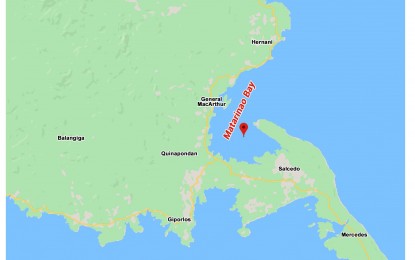
RETURN OF RED TIDE. A portion of Eastern Samar's map showing Matarinao Bay. The red tide toxin has recurred in Matarinao Bay in Eastern Samar, the Bureau of Fisheries and Aquatic Resources reported on Thursday (Aug. 18, 2022). (Bureau of Fisheries and Aquatic Resources map)
TACLOBAN CITY – Red tide has recurred in Matarinao Bay in Eastern Samar six months after it was declared toxin-free, the Bureau of Fisheries and Aquatic Resources (BFAR) reported on Thursday.
The sustained warm weather in the past weeks and sudden rainfall are among the factors that triggered the recurrence of the red tide phenomenon, the BFAR regional office said in a statement.
“The soil erosion has caused upwelling and led the red tide-causing cyst of the dinoflagellates to resurface and bathe with the organic matter from the sediments resulting in sudden bloom,” BFAR Eastern Visayas regional director Juan Albaladejo said.
Matarinao Bay covers the coastal waters of General MacArthur, Hernani, Quinapondan, and Salcedo in Eastern Samar.
BFAR lifted the shellfish ban in Matarinao Bay in February.
The recurrence of red tide in the area prompted BFAR to step up its monitoring in nearby bays for the possible spread of toxins.
Fish, squid, crab, and shrimp gathered from these areas are safe to eat provided that all entrails are removed and washed thoroughly with running water before cooking.
The BFAR asked local government units to heighten their watch against the gathering, trading, and consumption of shellfish and other bivalve marine products to prevent paralytic shellfish poisoning (PSP).
PSP occurs from ingesting bivalve shellfish, such as mussels, oysters, and clams, that contain red tide toxins.
Red tide is a term used to describe a phenomenon where the water is discolored by a high concentration of algae. (PNA)
